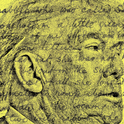Book: Looking for Spinoza
Author: Antonio Damasio
Price: Heinemann, £20
In his book "Descartes' Error", Antonio Damasio took issue with two aspects of Descartes's thought-his use of clockwork as a metaphor for the mind, and his statement of priorities: cogito ergo sum. Damasio reverses this, and shows how the life of the mind arises from the life of the body. He finds the idea of mind as computer programming, as hard-wiring, to be a misleading descendent of the clockwork metaphor. He deals in the "wet stuff" of the living tissues of body and brain. In "Descartes' Error", he gave us a plausible and beautiful idea of how our sense of self and our thought processes arise out of a series of nervous mappings of the body by the brain-from the unconscious visceral reporting to the conscious appetites, to memory and reflection. He does this partly by showing us what happens in brain-damaged people, distinguishing between those who live in vegetative states, those who have lost certain precise things (the left side of the body, or short-term memory, or a sense of responsibility) and those who think and feel more or less as most of us do.
In "Looking for Spinoza", he extends his researches into the contribution of emotions and feelings to the constitution of our selves. My only real problem with this book is with the ordinary language slipperiness of two words which Damasio uses very precisely. "Emotions," for Damasio, are involuntary responses like pleasure, pain, disgust and fear, which arise with the appetites early in the life of the body (and which in some cases are innate). "Feelings" are maps and images in the brain of its responses to sensory and emotional stimuli, both external and internal. Both emotions and feelings are an inextricable part of the way we take in the world-including the way we think. Damasio is very persuasive on how we could not survive without the social emotions that have evolved within us. But his greatest skill is making his readers feel the process by which our nervous system maps our body, its surroundings, its history, its needs and its decisions at every moment in our brains. He disposes elegantly of the idea that a metaphorical homunculus sits in our skulls making immutable representations of things to some inner eye, and replaces him with a shifting stream of signals, reinforcing, correcting, congregating into ideas of things and ourselves.
The mind, he says, is "filled with images from the flesh and images from the body's special sensory probes." He believes we form most of our ideas from messages from the "body-proper," and that the idea of self is a secondary idea, an idea of an idea, which we originally derive from the combination of the perception of an object with our perception of our own body.
Spinoza, he claims, is the first modern philosopher because he understood that body and mind were indivisible. For Spinoza, the mind-body is part of nature and the whole of nature is divine-an impersonal divinity which can be contemplated with delight and religious emotion and feeling. Damasio tells us that he returned to Spinoza when checking the accuracy of a quote he had kept from student days, which said that "the foundation of virtue is the endeavour to preserve the individual self, and happiness consists in the human capacity to preserve itself"-a notion of biological survival as the essence of humanity which is Darwinian before its time.
Damasio's book is an exploration of the meaning of this preservation of the self and this idea of happiness. It is also a biography of Spinoza and the story of Damasio's own relations with him. It is interesting that scientists working on memory and consciousness seem particularly to feel the need to embody their ideas in stories, which is also to describe their limitations in time and space. Both Daniel Alkon and Steven Rose have written autobiographies in which they have embedded their work on the biology of memory.
Spinoza was born in Amsterdam in 1632, the year Rembrandt painted "The Anatomy Lesson of Dr Tulp", and died young in the Hague. He knew Leibniz and Huygens. Even in tolerant Holland, he was proscribed as a heretic and, as Damasio movingly tells us, was excommunicated by his own Sephardic community with a comprehensive curse. He was a lensmaker, a concrete contributor to the scientific revolution which revealed the seen world in other aspects, and showed us an unseen world we had not imagined. Damasio-himself, it seems, a man who needs the religious feelings and emotions-joins Goethe in admiring the "freedom" and "blessedness" of the experience of Spinoza's "amor intellectualis Dei", an intellectual love for God. He also notes that the optical and mechanical devices of Spinoza's time were developed "both to permit scientific discovery and to make the discovery process a source of pleasure." (A question he doesn't ask-it is raised by Richard Gregory in "Eye and Brain"-is: what has it done to us to find ourselves in a world of experiences and objects, such as quantum physics, prions, DNA, that our senses were not evolved to deal with?)
Damasio also traces the influence of Spinoza on later times, pointing out that William James's "Varieties of Religious Experience" originated in a reading of Spinoza in 1888 when James was teaching a Harvard course on the philosophy of religion. James is another of Damasio's heroes-he says his insights on the human mind "have been rivalled only by Shakespeare's and Freud's." Damasio tells us drily how Freud confessed in private that his thought depended on Spinoza's teachings but that he never cited him directly-because, he claimed, it was the person and general atmosphere of thought of Spinoza that were important to him. It would be interesting to read Damasio on his own ideas of the bodily conscious and unconscious, and how they relate to those of Freud, whom he cites with admiration.
Resistance to Spinoza, as well as cautious excitement about his vision of things, is wound into the history of western art and thought. The German Romantics-Jacobi, Novalis, Lessing and Goethe (the scientist poet who worked on the way vision was formed in the brain)-responded to him and cited him. Wordsworth and Coleridge were both interested in the science of "feelings" and their relation to thought. Wordsworth's poet, a man of "more than usual organic sensibility [who has]... also thought long and deeply," is more Spinozan than Cartesian. Both poets began pantheist and retreated into cautious trinitarian Christianity. There is an excellent essay in Alan Richardson's "British Romanticism and the Science of the Mind" which discusses Kubla Khan as an image of "the conjunction of dreams and the unconscious, the embodied mind and the 'Gastric Life,'" and mentions recent work in cognitive neuroscience and the "wetware" as a development of Romantic brain science.
Damasio mentions George Eliot's interest in Spinoza in passing, but does not record that she spent a considerable part of her life translating both the Ethics and the "Tractatus". They were not published in her lifetime, but if the brilliance of her Feuerbach is anything to go by, it would still be interesting to have them made available. "Middlemarch" is the great novel of the body-mind exploration. The priest of old religion, Casaubon, is lost with a guttering candle in cobwebbed catacombs in search of an exploded sun god. The candle is Cartesian reason; the eye is, to quote Coleridge, the "soliform" organ which perceives the Light. But the modern doctor and microscopic researcher, Lydgate, is looking for the primitive tissue that makes all the body one. He knows what a difference Vesalius's discovery of the web of our nerves made to our sense of ourselves; he knows that there are "passions of the mind." He is Spinozan and Damasian (but emotionally stupid). The novelist, an embodied mind, ties her novel together with a great web of sensuous and cultural metaphor, which includes spiders, the threads of village gossip, the draperies in St Peter's in Rome, red "like a disease of the retina."
There has been a modern tendency to treat accounts of human consciousness which "privilege" the eye and the "sovereign reason" with a contemptuous political analogy, as though vision made claims to be aristocratic or male, or white-skinned, according to which hierarchy one is condemning. This is unhelpful. But the study of embodied consciousness is leading us to reconsider all kinds of aesthetic problems and proceedings. Svetlana Alpers's book on 17th-century Dutch painting turned away from allegorical emblems to optics-to the Dutch delight in the discovery of the outer world, aided by lenses. She remarks that the Dutch artist somehow sees the world with the whole body, not with the professional eye organising a perspective in a frame. The scientists who write on physics argue that the world they reveal is more amazing than any theological narrative of the heavens-more beautiful, more awe-inspiring. So too with the intricate human world revealed by the study of the embodied mind, to which Damasio has made such a distinguished contribution.











